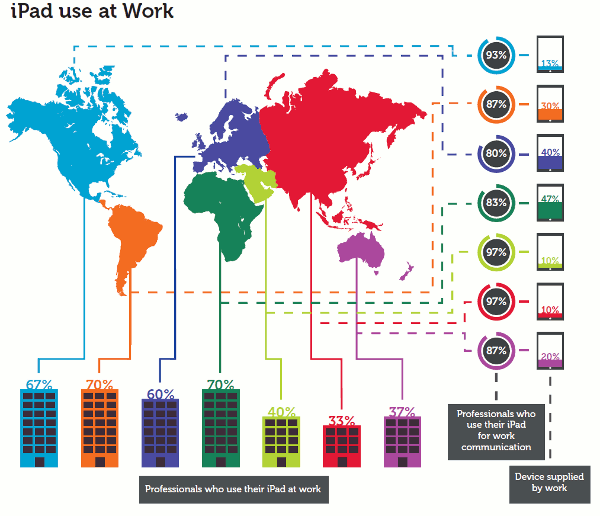Who knows maybe it was IDGs data because…
Hi there. While I’m sitting here waiting for my site to crash and burn, morderating comments on that other post that „miraculously“ got a ton of hits, I got around to reading my favorite German iOS website (no sarcasm, it really is the best German iOS site IMHO) and found another piece of „research“ by IDG (I’ll explain the quotes in a moment).
(Source: IDG)
Neat info, right?
That’s page two of the PDF. On page three we find this
„IT and business professionals use their iPads more intensively, across
a wider range of scenarios.“
and, in tinier letters on the lower right:
(3) This survey is based upon telephone interviews with 210 respondents worldwide,
conducted in October 2011 on behalf of IDG Connect.
Right. 210 respondents worldwide. Seven colors, seven regions. Let’s devide 210 by 7. That’s 30.
Now how many states are there in the US alone? How many IT and „Business Professionals“ are working in how many companies in those 50 states plus Mexico and Canada. Again – 30 surveys returned per color.
I don’t know if I need to explain to the layman reader that it’s kind of hard to find out if the Web Developers in Saskatoon are really using their iPads at work when the chances are high that the only company that got called in Canada was located in Quebec. And that maybe instead of calling one company in California IDG called, say, two. And none in Montana.
Or put another way: there are 3 million registered businesses in Germany who have to pay sales tax. Germany, a country with 82 million people (the US has roughly 350 million citizens). Two thirds of those German businesses are single person. One worker. One boss. One person. Let’s lowball and guess that only 10% of those are IT businesses, which would make it 300,000.
Europe consists of roughly 50 countries. 30 of them were called. Hopefully Germany got a call.
ONE in 300,000 companies most likely got a call in Germany. 200,000 of those companies most likely have ONE worker.
Now look at the graph again.
…
I guess people who work in IT got an iPad for Christmas and „took it to work“.
Thanks IDG.
(What I’m trying to tell the reader is this: if you just ask ONE person in Germany if they take their iPad to work and if their company bought it for them you can’t really tell how many iPads are in companies in Germany – let alone in Kenya. This IT business pro is sitting in his sweat pants in front of the monitor right now listening to a Podcast on his iPad.
And don’t get me started talking about the iPad’s staggered release and number of businesses in the world compared to iPads available. Apple still sells every single iPad they produce and they crank them out as fast as they can and IDG thinks they can make offer opinions about adoption rate. I think IT Pros got iPads if they were lucky and „Hell yeah I’m bringing my new gadget to work!“)



Oh…this will be fun. Enjoying the first Apple óutsider blogposts.
*blush*
If it’s only half as much fun as commenting on iphoneblog.de has been in the last five years I’d be more than happy 🙂
HI
In the study it is written:
„According to one recent survey of US consumers, 60% of iPads never leave the home, and 70% of usage occurs in the living room.(3)“
And this (3) actually refers to the note (3) : „This survey is based upon telephone interviews with 210 respondents worldwide, conducted in October 2011 on behalf of IDG Connect.“
So this note (3) is refering to another survey of 210 participants, not to the 2012 ipad Study.
I never found their methodology for this study though, they di not specify it anywhere, so I agree with you when you say we can not take this numbers for granted…
Hi Camille.
After looking at the PDF I have to admit that you are right. The survey (3) was about „customers“ and „home“ and the next paragraph tries to juxtapose those customers with the findings in this study, namely business customers.
So my criticism should be applied to 210 telephone interviews to gauge the usage of home use of 7 BILLION people (ok let’s say 3 billion in the first and developing world), not just businesses. Because every business-user of course is also a potential home user, right?
Anyway „these professionals differ from the broad population of consumers in this respect“ should’ve been clear enough for me to understand that IDG talked about two different groups of users. My bad.
And you are right – in the end we know _nothing_ about the methodology. Maybe it’s even worse – usually in scientific papers you outline your methodology first and then give the reader the numbers – and IDG basically put up a smoke screen. All I can now find is that infobox on the left saying that they „utilize“ 35 million decision makers details.
Whatever that means.
I’m really glad you pointed this out. (no sarcasm). Thank you so much for your comment!